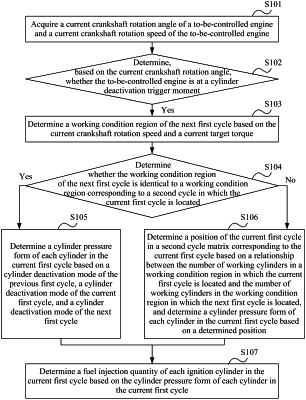| CPC F02D 41/0087 (2013.01) [F02D 41/009 (2013.01); F02D 2200/0614 (2013.01); F02D 2200/1002 (2013.01); F02D 2200/101 (2013.01)] | 20 Claims |

|
1. A cylinder deactivation control method of an engine, comprising:
acquiring a current crankshaft rotation angle of a to-be-controlled engine and a current crankshaft rotation speed of the to-be-controlled engine;
determining, based on the current crankshaft rotation angle, whether the to-be-controlled engine is at a cylinder deactivation trigger moment;
in response to a determination that the to-be-controlled engine is at the cylinder deactivation trigger moment, determining a working condition region of a next first cycle based on the current crankshaft rotation speed and a current target torque;
determining whether the working condition region of the next first cycle is identical to a working condition region corresponding to a second cycle in which a current first cycle is located;
in response to a determination that the working condition region of the next first cycle is identical to a working condition region corresponding to the second cycle in which the current first cycle is located, determining a cylinder pressure form of each cylinder in the current first cycle based on a cylinder deactivation mode of a previous first cycle, a cylinder deactivation mode of the current first cycle, and a cylinder deactivation mode of the next first cycle;
in response to a determination that the working condition region of the next first cycle is different from the working condition region corresponding to the second cycle in which the current first cycle is located, determining a position of the current first cycle in a second cycle matrix corresponding to the current first cycle based on a relationship between a number of working cylinders in a working condition region in which the current first cycle is located and a number of working cylinders in the working condition region in which the next first cycle is located, and determining a cylinder pressure form of each cylinder in the current first cycle based on a determined position of the current first cycle in the second cycle matrix corresponding to the current first cycle; and
determining a fuel injection quantity of each ignition cylinder in the current first cycle based on the cylinder pressure form of each cylinder in the current first cycle.
|